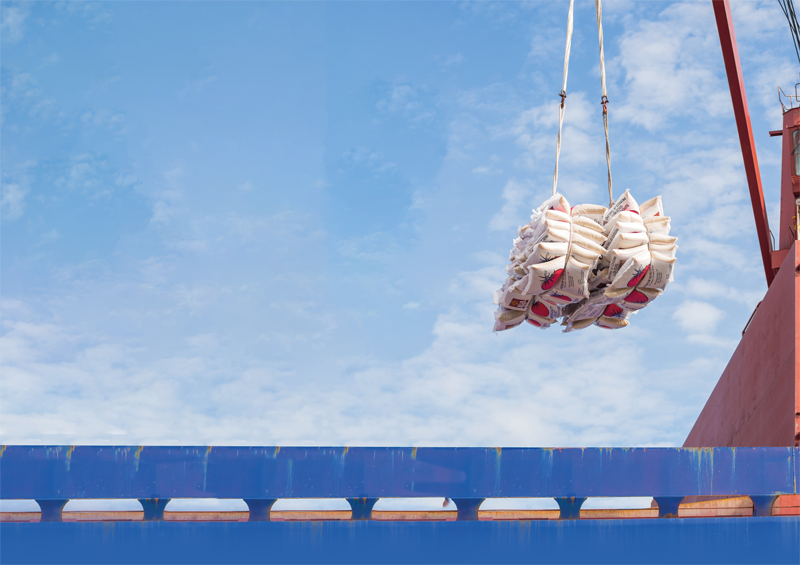Bagged Cargo Ventilation Channels - Do They Work?
Charterers or shippers often request that ventilation channels are built into the stow of bagged cargoes – but experts have advised north that their effectiveness is unproven.
A recent dispute arose between a vessel and stevedores over what was the “correct” way to construct ventilation channels within the stow of bagged agricultural cargoes. This article considers the conflicting advice currently out there and called on experts to give their opinions on the effectiveness of these ventilation channels.
Agricultural cargoes such as grains and rice are traded globally and regularly shipped in bags. These cargoes are hygroscopic.
It is common for the vessel to be given specific stowage and ventilation requirements. One common requirement is for ventilation channels to be built into the stow and has been a longstanding practice.
Limited Effect
CWA International explain that the idea behind ventilation channels is to allow hot, moisture laden air to rise up through the channels and be removed by the air flow generated by ventilators aligned with the channels. Therefore, the main purpose of the channels is to increase the surface area of the stow to allow warm air to rise and then be removed during ventilation.
However, most bulk vessels carrying bagged agricultural cargoes can only facilitate natural ventilation during a voyage and this is less effective than mechanical ventilation.
Experts have advised North that the effectiveness of these channels is unproven. There are no specific studies which compare whether a bagged cargo stow built with ventilation channels improves the cargo condition at outturn compared with a bagged stow built without.
CWA stated that they have seen numerous cases where the ventilation channels were not constructed properly and collapsed during the voyage.
Focus on Sweat
Going further, other leading experts advised that there is no advantage in getting airflow into a channel within a block stow of bags. They informed that neither rice nor wheat in bags actually needs a supply of air and the only significance of ventilation is in the context of condensation/sweat.
Ship’s sweat is the condensation that is generated when warm moist air in the cargo hold comes into contact with the cold steelwork of the vessel. This effect is greatest when loading cargo in warm humid climates and the vessel then transits a cooler area.
The moisture that forms on the exposed steelwork then drips onto the bagged cargo and can lead to mould growth. Effective airflow is therefore most needed at the sides of the hold where the risk of sweat damage is greatest and across the stow surface.
Vessel action
It should be stressed that these doubts on the efficacy of ventilation channels does not mean that a master should refuse them to be built into the stow. In fact, guidance on bagged rice cargoes in Thomas’ Stowage specifically refers to ventilation channels. But the master and crew should be aware of the potentially limited effectiveness of ventilation channels and the risk of collapse if they are not constructed properly.
Most bagged agricultural cargo claims involve freshwater staining – therefore the main risk of wet damage relates to ship’s sweat. Efforts must be concentrated on reducing sweat and using appropriate dunnage to prevent direct contact between the cargo and the vessel’s steelwork.
Furthermore, the carrier has an obligation to care for the cargo and this includes ventilation. Maintaining proper records to show ventilation was carried out in accordance with either the three-degree rule or the dew-point rule will act as valuable evidence when defending a claim of wet damage.
Find out more
For more information, please read North’s Loss Prevention Briefing on agricultural cargoes www.nepia.com/LP-Briefings or visit our Members’ Area and look at our ventilation guide on www.nepia.com


 , you have now set your site language to English. If you'd like to change your language preference again, simply click on one of the other flags.
, you have now set your site language to English. If you'd like to change your language preference again, simply click on one of the other flags. を選択して頂くと、言語設定が日本語に切り替わります。設定変更後は以下の機能が利用可能です。
を選択して頂くと、言語設定が日本語に切り替わります。設定変更後は以下の機能が利用可能です。
 ,可将网站语言设置为中文。这能帮助您:
,可将网站语言设置为中文。这能帮助您:

